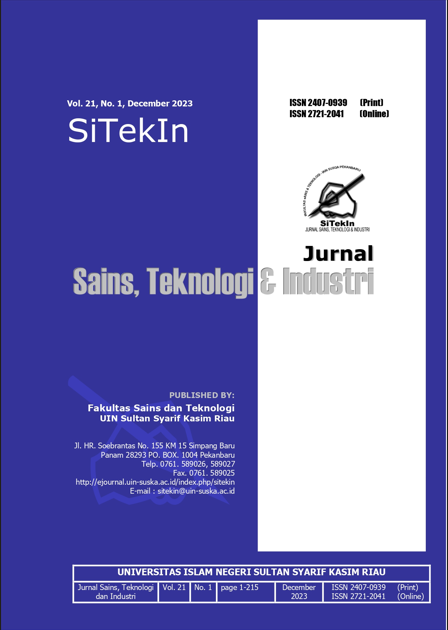Utilization of Electronic Nose to Detect Quality of Meat in the Beef Ribs section
DOI:
https://doi.org/10.24014/sitekin.v21i1.27066Abstract
This study analyzes the use of Electronic Nose (E-Nose) in detecting the quality of beef on the ribs. This experiment used a variety of gas sensors, and found a significant pattern related to rib meat quality. There are three sensors, namely MQ137, MQ5, and MQ6, which show the value is inversely proportional to the other sensors. An increase in the value of this sensor indicates a decrease in the quality of the ribs. Furthermore, MQ8 gave the highest score in the "Good" and "Excellent" categories, while MQ5 and MQ6 gave the highest score in the "Equal" and "Not Eligible" categories. The analysis revealed that E-Nose has the ability to recognize changes in aroma associated with changes in the quality of rib meat. These results show that E-Nose can provide objective and fast information about the quality of beef in the ribs, which can support the food industry in decision making and product quality control. Further research is needed to optimize the use of sensors and validate this technology in various storage conditions and types of beef.
References
K. K. Agustina, I. Cahya, G. M. Widyantara, I. B. N. Swacita, A. Dharmayudha, and M. D. Rudyanto, “Nilai gizi dan kualitas fisik daging sapi bali berdasarkan jenis kelamin dan umur,” Bul. Vet. Udayana, vol. 9, no. 2, pp. 156–163, 2017.
B. Bahar, Panduan praktis memilih produk daging sapi. Gramedia Pustaka Utama, 2003. [Online]. Available: https://books.google.co.id/books?id=LTsiHpCCHLEC
Standar Nasional Indonesia, “Mutu karkas dan daging sapi SNI 3932:2008,” Badan Stand. Nas., vol. 3932, p. 2008, 2008.
A. Loutfi, S. Coradeschi, G. K. Mani, P. Shankar, and J. B. B. Rayappan, “Electronic noses for food quality: A review,” J. Food Eng., vol. 144, pp. 103–111, 2015, doi: 10.1016/j.jfoodeng.2014.07.019.
Badan Pusat Statistik, “Peternakan Dalam Angka tahun 2022,” Jakarta, 5301008, 2022.
E. F. Anggara, T. W. Widodo, and D. Lelono, “Deteksi Daging Sapi Menggunakan Electronic Nose Berbasis Bidirectional Associative Memory,” IJEIS (Indonesian J. Electron. Instrum. Syst., vol. 7, no.
, p. 209, 2017, doi: 10.22146/ijeis.25489.
Radi, E. Wahyudi, M. D. Adhityamurti, J. P. L. Y. Putro, Barokah, and D. N. Rohmah, “Freshness assessment of tilapia fish in traditional market based on an electronic nose,” Bull. Electr. Eng. Informatics, vol. 10, no. 5, pp. 2466–2476, 2021, doi: 10.11591/eei.v10i5.3111.
I. Kresnawaty et al., “Electronic nose for early detection of basal stem rot caused by Ganoderma in oil palm,” IOP Conf. Ser. Earth Environ. Sci., vol. 468, no. 1, p. 012029, Mar. 2020, doi: 10.1088/1755-1315/468/1/012029.
L. Capelli, S. Sironi, and R. Del Rosso, Electronic noses for environmental monitoring applications, vol. 14, no. 11. MDPI AG, 2014. doi: 10.3390/s141119979.
N. Firmawati and K. Triyana, “Kelayakan Teknologi Electronic Nose untuk Mendeteksi Urin yang Mengandung Metadon dengan Menggunakan Principal Component Analysis (PCA),” J. Ilmu Fis. |
Univ. Andalas, vol. 8, no. 1, pp. 45–51, 2016, doi: 10.25077/jif.8.1.45-51.2016.
E. A. Baldwin, J. Bai, A. Plotto, and S. Dea, “Electronic noses and tongues: Applications for the food and pharmaceutical industries,” Sensors, vol. 11, no. 5, pp. 4744–4766, 2011, doi: 10.3390/s110504744.
G. Villarrubia, J. F. De Paz, D. Pelki, F. de la Prieta, and S. Omatu, “Virtual organization with fusion knowledge in odor classification,” Neurocomputing, vol. 231, pp. 3–10, 2017, doi:
1016/j.neucom.2016.05.106.
L. Zhang, F. Tian, and D. Zhang, Electronic Nose: Algorithmic Challenges. 2018. doi: 10.1007/978-981-13-2167-2.
C. A. Lintang, T. W. Widodo, and D. Lelono, “Rancang bangun electronic nose untuk mendeteksi tingkat kebusukan ikan air tawar,” IJEIS, vol. 6, no. 2, pp. 129–140, 2016.
Radi, M. Rivai, and M. H. Purnomo, “Study on electronic-nose-based quality monitoring system for coffee under roasting,” J. Circuits, Syst. Comput., vol. 25, no. 10, 2016, doi:10.1142/S0218126616501164.
C. Zhang, W. Wang, Y. Pan, and S. Zhai, “Rapid gas detection for electronic noses using optimal measurement time search and multi-sensor energy change based feature extraction,” Meas. J. Int. Meas. Confed., vol. 204, 2022, doi: 10.1016/j.measurement.2022.112101.
D. R. Wijaya, R. Sarno, and E. Zulaika, “Electronic nose dataset for beef quality monitoring in uncontrolled ambient conditions,” Data in Brief, vol. 21. pp. 2414–2420, 2018. doi:10.1016/j.dib.2018.11.091.
Downloads
Published
Issue
Section
License
This work is licensed under a Creative Commons Attribution-ShareAlike 4.0 International License
Copyright Notice
An author who publishes in the SITEKIN Journal agrees to the following terms:
- Author retains the copyright and grants the journal the right of first publication of the work simultaneously licensed under the Creative Commons Attribution-ShareAlike 4.0 License that allows others to share the work with an acknowledgement of the work's authorship and initial publication in this journal
- Author is able to enter into separate, additional contractual arrangements for the non-exclusive distribution of the journal's published version of the work (e.g., post it to an institutional repository or publish it in a book) with the acknowledgement of its initial publication in this journal.
- Author is permitted and encouraged to post his/her work online (e.g., in institutional repositories or on their website) prior to and during the submission process, as it can lead to productive exchanges, as well as earlier and greater citation of the published work (See The Effect of Open Access).
Read more about the Creative Commons Attribution-ShareAlike 4.0 Licence here: https://creativecommons.org/licenses/by-sa/4.0/.

